41 Lyn (**)
|
| Name: |
41 Lyn, S598 |
| Type: |
** |
| Constellation: |
UMa |
| Coordinates: |
09h28m39.99s / +45°36'06.50" |
| Components: |
|
|
m1 |
m2 |
ρ |
θ |
Year |
|
AB |
5m.5 |
7m.8 |
69.7" |
160° |
2017 |
|
|
|
|
This star has the designation 41 Lyn but is assigned to UMa. At the time, when Flamsteed numbered the stars, the constellation boundaries were not exactly defined. Another example is 10 UMa, which is located in Lyn today.
|
|
| Robert Zebahl |
B 8x40, Bortle 7, NELM 5m.0, SQM-L 19.2
Fairly well split with fainter component.
|
|
|
67 UMa (**)
|
| Name: |
67 UMa |
| Type: |
** |
| Constellation: |
UMa |
| Coordinates: |
12h02m06.80s / +43°02'44.30" |
| Components: |
|
|
m1 |
m2 |
ρ |
θ |
Year |
| FOR1 |
AB |
5m.2 |
6m.7 |
274.4" |
62° |
2015 |
| ARN5 |
AC |
5m.2 |
8m.5 |
375.9" |
25° |
2015 |
| FOR1 |
AD |
5m.2 |
8m.9 |
363.2" |
268° |
2015 |
|
| Robert Zebahl |
B 8x40
2020-04-05: The pair AB stands out immediately and shows itself in beautiful colors: A white-yellowish, B slightly orange. Almost at right angles to pair AB component C is visible as a faint star at a slightly smaller distance. I did not pay attention to the even fainter component D.
|
|
55mm f/9.1, 27x
2020-04-05: Components A, B and C easily visible with decreasing brightness. I did not consider component D. A: white-yellowish, B: pale orange. I liked the view in the 8x40 binoculars better.
|
|
|
AG 190 (**)
|
| Name: |
AG190 |
| Type: |
** |
| Constellation: |
UMa |
| Coordinates: |
13h35m38.82s / +49°39'21.70" |
| Components: |
|
|
m1 |
m2 |
ρ |
θ |
Year |
|
|
9m.6 |
9m.8 |
2.6" |
13° |
2017 |
|
| Robert Zebahl |
70mm f/5.7, 80x, Bortle 6, SQM-L 19.4
2020-04-20: Pretty faint double star. At 80x still very tight pair with little difference in brightness. Not very attractive.
|
|
|
BU 408 (**)
|
| Name: |
BU408 |
| Type: |
** |
| Constellation: |
UMa |
| Coordinates: |
08h59m00.62s / +63°25'42.80" |
| Components: |
|
|
m1 |
m2 |
ρ |
θ |
Year |
|
|
7m.3 |
9m.6 |
2.8" |
345° |
2018 |
|
| René Merting |
100mm f/6.4, 142x, SQM-L 21.0
bei 107x ist nordöstlich von A ein Helligkeitspeak erkennbar, aber nicht richtig greifbar - bei 142x dann zeigt sich in ruhigen Momenten die schwächere Komponente knapp abgesetzt von A - großer Helligkeitsunterschied, mindestens 2.5 Größenklassen
|
|
|
BU 1077 (**)
|
| Name: |
BU1077, alpha UMa, 50 UMa, Dubhe |
| Type: |
** |
| Constellation: |
UMa |
| Coordinates: |
11h03m43.84s / +61°45'04.00" |
| Components: |
|
|
m1 |
m2 |
ρ |
θ |
Year |
|
AB |
2m.0 |
5m.0 |
0.8" |
342° |
2017 |
|
AC |
2m.0 |
7m.2 |
384.5" |
206° |
2020 |
|
|
|
|
|

|
|
| Robert Zebahl |
152mm f/8, 200x, Seeing 3/5
AB: 2022-04-12: At magnifications between 200x and 400x, there was nothing even close to a double star to be seen. The air was simply too turbulent.
|
|
70mm f/5.7, 22x
AC: 2020-04-07: Very wide, uneven & inconspicuous pair. A appeared white-yellowish, for C I could not detect any color.
|
|
152mm f/8, 43x, Seeing 3/5
AC: 2022-04-12: Very wide and uneven pair. Component A shines in a bright, brilliant orange, companion C looks rather white.
|
|
| René Merting |
B 18x70, SQM-L 21.0
AC: Dubhe oder Alpha Ursae Majoris - hm, naja - C zeigt sich im Süden in Riesenabstand zum intensivgelbem A - Komponente C wirkt dagegen wie eine graue Maus und der Helligkeitsunterschied ist so enorm, dass er nicht abschätzbar ist
|
|
76mm f/7.5, 29x, SQM-L 19.4
AC: die A-Komponente präsentiert sich bei 29x als wunderschön sattgelb strahlender Stern mit ordentlichem Halo - die B-Komponente steht weit entfernt im Süden, wirkt mehr als drei Größenklassen schwächer und wirkt weißgrau
|
|
107mm f/5.6, 30x, SQM-L 21.1
AC: bei 30x weit, ach was, sehr weit auseinander stehend - Komponente B ist 3 Magnituden schwächer (nein, sogar 5 Magnituden lt. Stelle Doppie) - besonders imposant ist die Farbe von A, die sehr klar wirkt, champagnergelb würde ich sagen
|
|
|
iota UMa (**)
|
| Name: |
iota UMa, 9 UMa, Talitha |
| Type: |
** |
| Constellation: |
UMa |
| Coordinates: |
08h59m12.45s / +48°02'30.60" |
| Components: |
|
|
m1 |
m2 |
ρ |
θ |
Year |
| HJ2477 |
A-BC |
3m.1 |
9m.2 |
2.4" |
90° |
2017 |
| HU628 |
BC |
9m.9 |
10m.1 |
0.9" |
206° |
2017 |
|
|
|
|
|
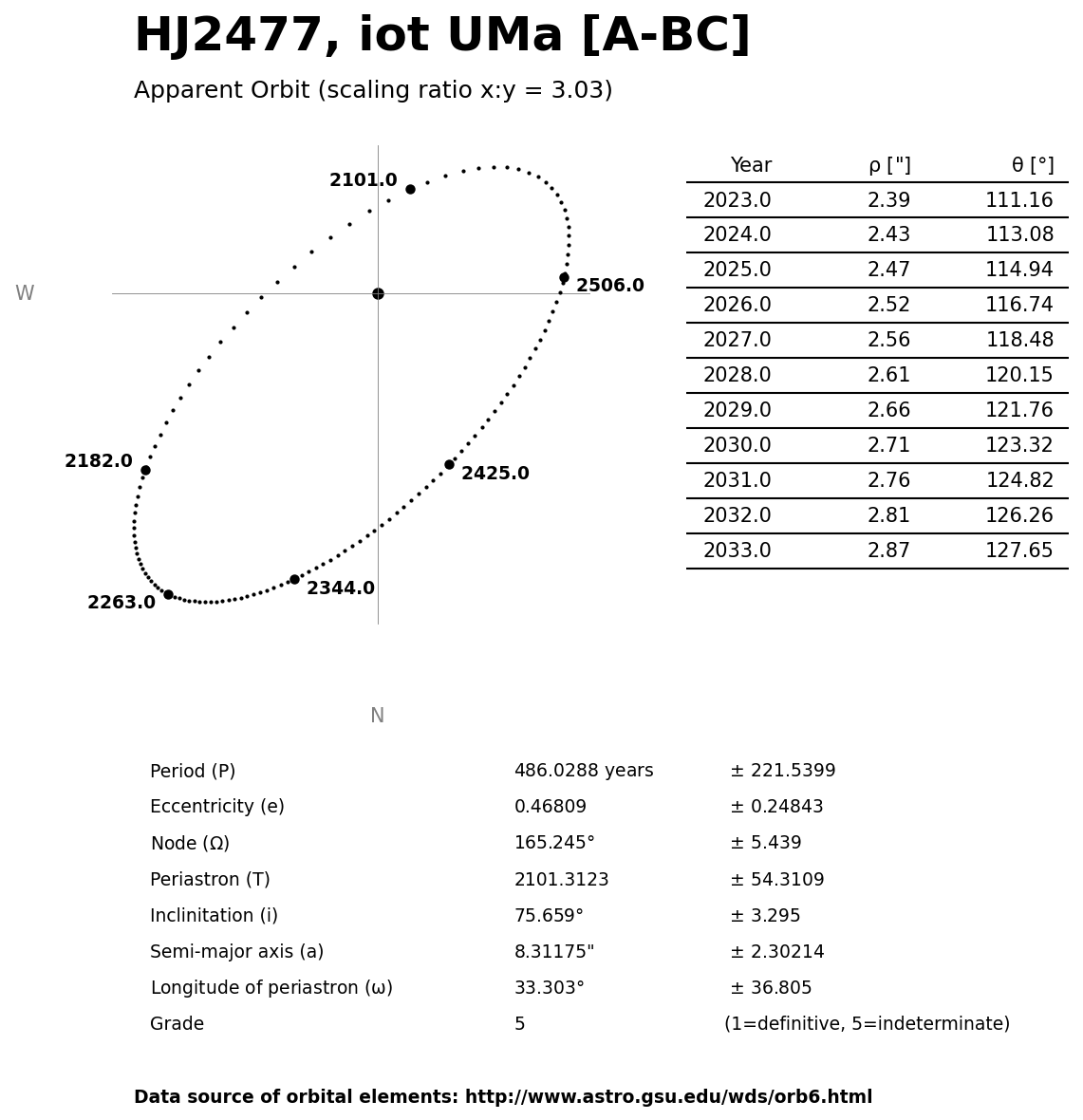
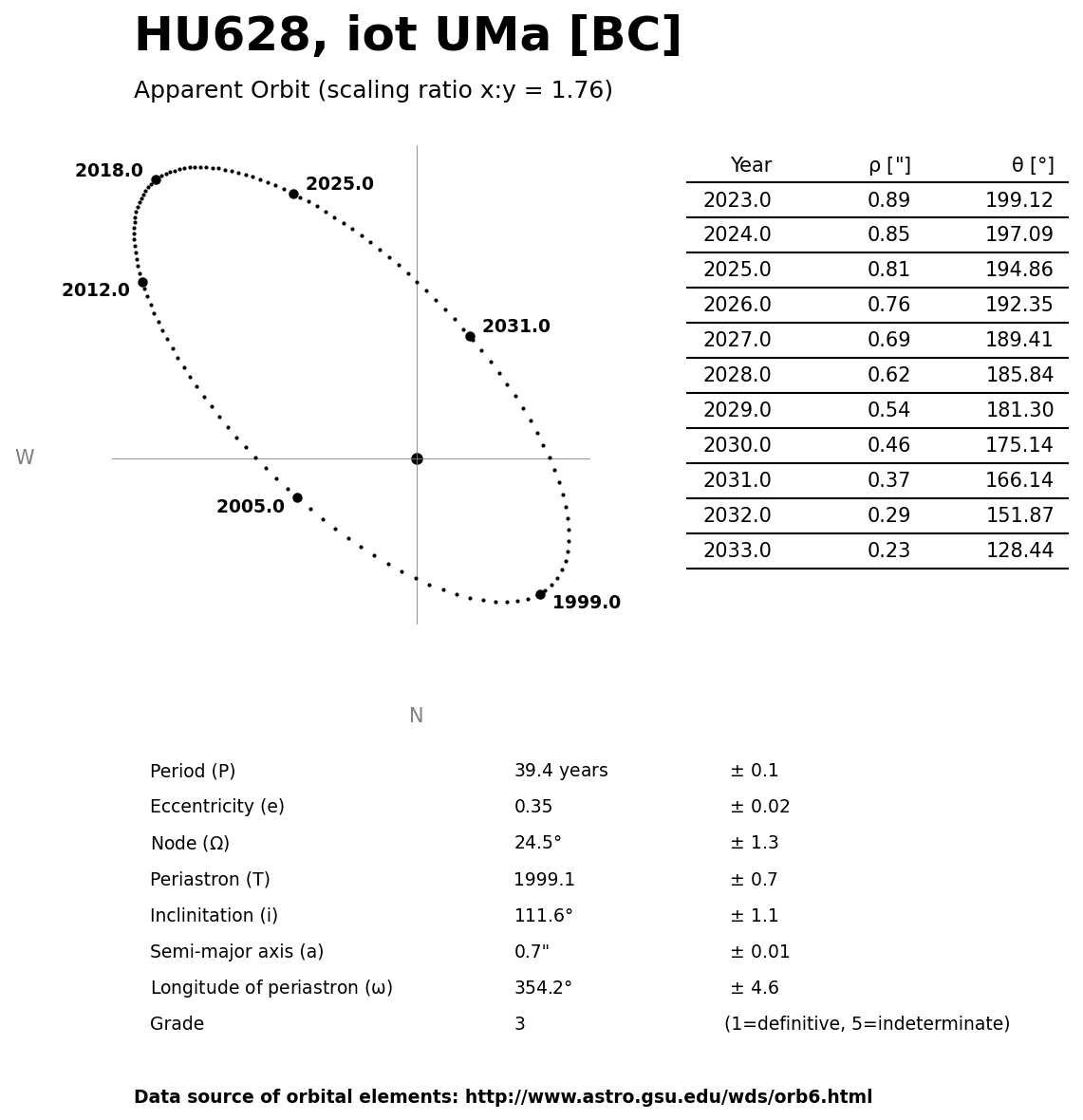
|
|
| Robert Zebahl |
152mm f/5.9, 300x, Bortle 6, SQM-L 19.4, Seeing 3/5
A-BC: 2020-04-24: The seeing (3/5) was not good enough for a split.
|
|
|
Messier 40 (**)
|
| Name: |
Messier 40, M40, Winnecke 4, WNC4 |
| Type: |
** |
| Constellation: |
UMa |
| Coordinates: |
12h22m12.53s / +58°04'58.60" |
| Components: |
|
|
m1 |
m2 |
ρ |
θ |
Year |
|
|
9m.7 |
10m.2 |
53.2" |
76° |
2017 |
|
|
|
|
Winnecke 4 is an optical double star with an angular distance of 50 arc seconds. Charles Messier had probably mistaken this double star as a nebula and therefore included it in his catalog. It is the only double star in Messier's catalog.
|
|
| Robert Zebahl |
B 16x70, Bortle 6-, SQM-L 19.2
2021-09-02: Easy to separate, but quite faint and inconspicuous. A small difference in brightness is visible.
|
|
| René Merting |
B 8x20, SQM-L 21.0
knapp direkt sichtbar, indirekt wie ein schwacher Stern - leicht diffuser Eindruck
|
|
B 8x30, SQM-L 21.0
beide Sterne sind sehr schwach als längliche Aufhellung zu erkennen, mehr nicht
|
|
B 10x50, SQM-L 21.0
zwei relativ einfach zu sehende schwache Sterne, ordentlich getrennt - beide Sterne sind gleich hell
|
|
B 16x70, SQM-L 21.0
Zenitbeobachtung (leider kein echter Vorteil im Fujinon) - direkt als kompakter nebliger Fleck erkennbar, indirekt offenbaren sich zwei Sterne
|
|
B 18x70, SQM-L 21.0
Zenitbeobachtung (definitiv ein Vorteil, weil besseres Einblickverhalten als beim Fujinon 16x70) - zwei relativ einfach zu sehende schwache Sterne, ordentlich getrennt - beide Sterne sind gleich hell
|
|
100mm f/6.4, 20x, SQM-L 21.0
bei 32x sind beide Komponenten gut getrennt erkennbar - beide Sterne sind schwach und ohne großen Helligkeitsunterschied, der Stern im Osten wirkt leicht schwächer - zurück auf 20x sind beide Sterne noch immer bequem getrennt voneinander zu bestaunen
|
|
8" f/4, 40x, SQM-L 21.0
bei 40x sind eindeutig zwei gleichhelle nah beieinander liegende Sterne auszumachen
|
|
12.5" f/4.5, 45x, SQM-L 21.0
ein Sternpaar, das komfortabel getrennt ist - beide Sterne wirken grauorange
|
|
|
STF 1193 (**)
|
| Name: |
STF1193 |
| Type: |
** |
| Constellation: |
UMa |
| Coordinates: |
08h20m40.32s / +72°24'26.00" |
| Components: |
|
|
m1 |
m2 |
ρ |
θ |
Year |
|
AB |
6m.2 |
9m.7 |
42.4" |
90° |
2015 |
|
BC |
9m.8 |
12m.7 |
58.8" |
6° |
2015 |
|
| Robert Zebahl |
70mm f/5.7, 22x, Bortle 6, SQM-L 19.3
AB: 2020-04-21: Beautifully separated with much fainter companion. The primary component shines in a bright, refreshing yellow. Rewarding!
|
|
| René Merting |
12.5" f/4.5, 45x, SQM-L 21.0
AB: bei 45x … oh wow, was für eine Farbe bei Komponente A - so ein intensives Gelb habe ich noch nirgends gesehen, gleißendes Rapsgelb - die deutlich schwächere Komponente B im Osten in weitem Abstand ist bei der Farbe von A eher uninteressant, B ist ohnehin nur grau schimmernd
|
|
|
STF 1258 (**)
|
| Name: |
STF1258 |
| Type: |
** |
| Constellation: |
UMa |
| Coordinates: |
08h43m25.41s / +48°51'41.90" |
| Components: |
|
|
m1 |
m2 |
ρ |
θ |
Year |
|
|
7m.7 |
7m.9 |
10.2" |
331° |
2021 |
|
| Robert Zebahl |
B 16x70, Bortle 7, SQM-L 18.6
2020-07-05: Immediately visible as a double star, separated but pretty close with similar bright components.
|
|
70mm f/5.7, 22x, Seeing 3/5
Easy to separate at 22x, similarly bright components at moderate distance. At 57x very small difference in brightness noticeable. The components appeared slightly orange and white-bluish, with the color changing from one component to another. A very strange effect, which I observed several times.
|
|
|
STF 1275 (**)
|
| Name: |
STF1275 |
| Type: |
** |
| Constellation: |
UMa |
| Coordinates: |
08h51m26.19s / +57°31'38.10" |
| Components: |
|
|
m1 |
m2 |
ρ |
θ |
Year |
|
AB |
8m.7 |
8m.9 |
1.9" |
198° |
2019 |
|
| Robert Zebahl |
70mm f/5.7, 100x
At 100x and 150x not permanently split. Components very close together.
|
|
|
STF 1280 (**)
|
| Name: |
STF1280 |
| Type: |
** |
| Constellation: |
UMa |
| Coordinates: |
08h55m24.82s / +70°47'39.20" |
| Components: |
|
|
m1 |
m2 |
ρ |
θ |
Year |
|
AB |
8m.8 |
9m.1 |
3.8" |
359° |
2022 |
|
AC |
8m.8 |
12m.4 |
398.4" |
88° |
2015 |
|
BC |
9m.1 |
12m.4 |
398.5" |
88° |
2015 |
|
|
|
|
|
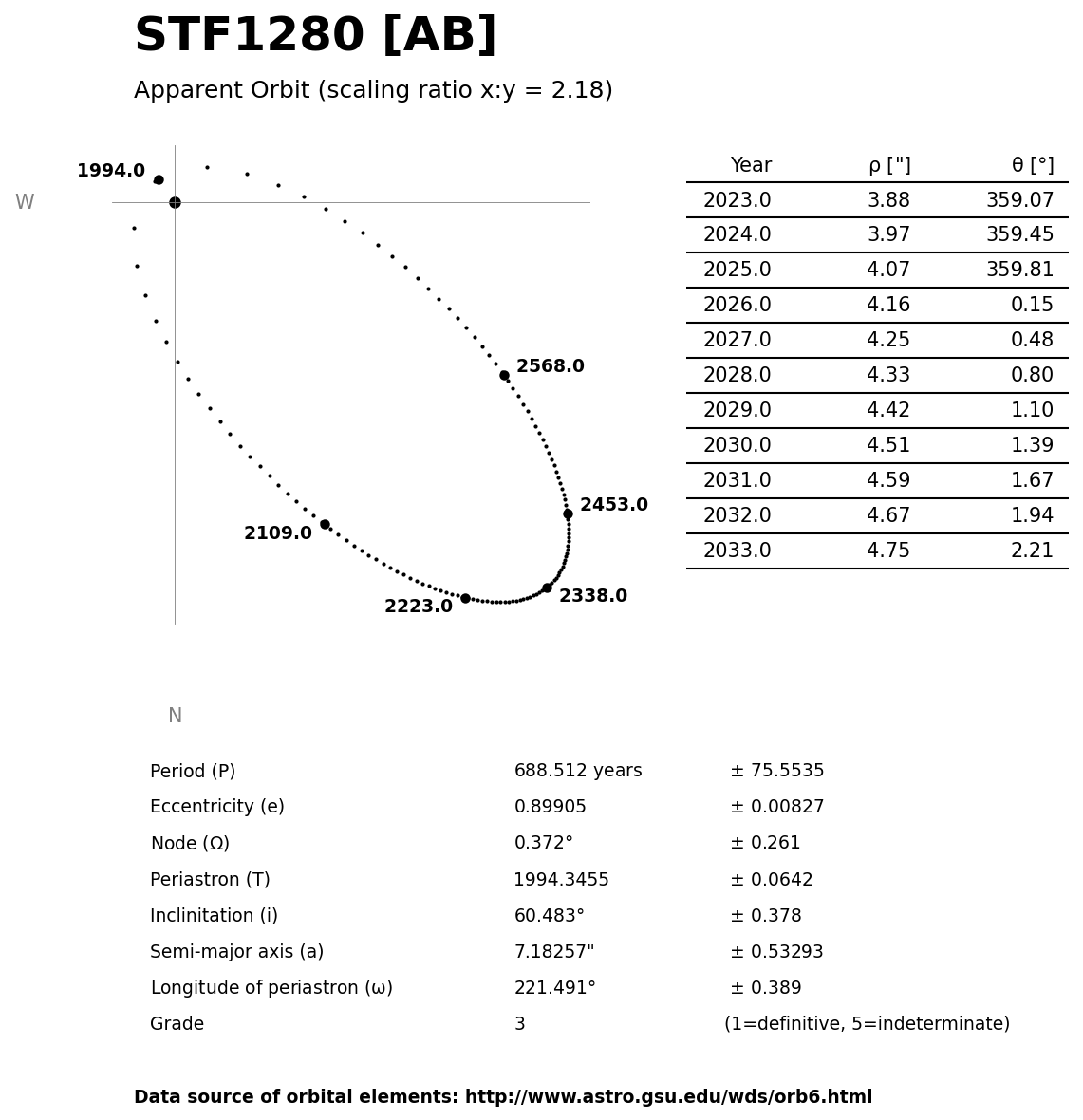
|
|
| Robert Zebahl |
70mm f/5.7, 67x, Bortle 6, SQM-L 19.2
AB: 2021-04-03: Rather faint double star with components still pretty close together and little difference in brightness.
|
|
| René Merting |
12.5" f/4.5, 72x, SQM-L 21.0
AB: bei 72x ein knapp getrenntes Sternpaar - beide Sterne sind annähernd gleich hell und strahlen rein weiß - bei 144x eine ordentlichere Trennung, Komponente A im Süden strahlt in einem wärmeren Weiß
|
|
|
STF 1306 (**)
|
| Name: |
STF1306, sigma 2 UMa, 13 UMa |
| Type: |
** |
| Constellation: |
UMa |
| Coordinates: |
09h10m23.53s / +67°08'03.30" |
| Components: |
|
|
m1 |
m2 |
ρ |
θ |
Year |
|
AB |
4m.9 |
8m.8 |
4.4" |
346° |
2020 |
|
AC |
4m.9 |
10m.3 |
197.8" |
148° |
2003 |
|
|
|
|
|
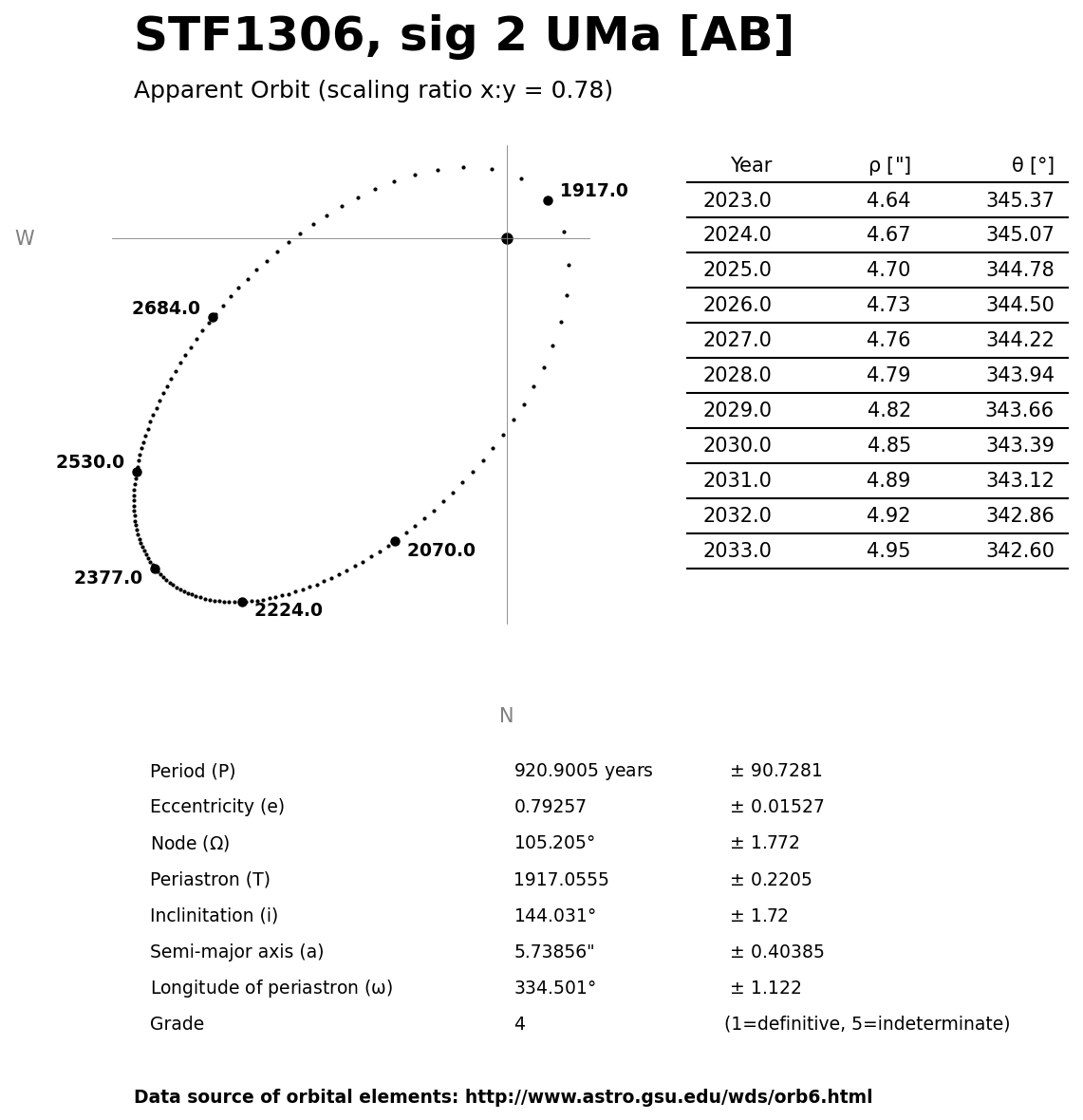
|
|
| Robert Zebahl |
70mm f/5.7, 100x, Seeing 3/5
AB: Companion almost permanently visible as elongated, non-condensed brightening of the first diffraction ring of the primary component at the correct position angle.
|
|
|
STF 1312 (**)
|
| Name: |
STF1312 |
| Type: |
** |
| Constellation: |
UMa |
| Coordinates: |
09h10m18.19s / +52°23'05.70" |
| Components: |
|
|
m1 |
m2 |
ρ |
θ |
Year |
|
|
8m.3 |
8m.8 |
4.8" |
149° |
2021 |
|
| Robert Zebahl |
70mm f/5.7, 44x, Bortle 6, SQM-L 19.6
2020-04-19: At 22x clearly elongated, at 31x instantly visible as '8', sometimes barely separated. At 44x clearly separated with little difference in brightness. For the perception of colors the double star was too faint. Together with STF 1321 visible in one field of view.
|
|
| René Merting |
76mm f/7.5, 57x, SQM-L 19.4
bei 57x ein knapp getrenntes Paar zweier gleich schwacher Sternchen - der Stern im Südosten ist minimal schwächer - wenn man erst einmal realisiert hat, dass es zwei Sterne sind, sieht es wunderschön aus
|
|
|
STF 1315 (**)
|
| Name: |
STF1315 |
| Type: |
** |
| Constellation: |
UMa |
| Coordinates: |
09h12m45.94s / +61°40'32.70" |
| Components: |
|
|
m1 |
m2 |
ρ |
θ |
Year |
|
|
7m.3 |
7m.7 |
24.7" |
27° |
2022 |
|
| Robert Zebahl |
70mm f/5.7, 22x, Seeing 3/5
Medium bright double star, easy to separate with attractive distance and slight difference in brightness. Together with 16 UMa in one field of view. The brighter component appeared slightly orange, the fainter one showed a hint of blue. However, the colors of the components changed over time. At 57x similar view.
|
|
| René Merting |
B 18x70, SQM-L 21.0
ja, der ist schick - ein gut getrenntes Sternpaar - zwei fast gleich helle Sterne - B im Nordosten ist vielleicht eine viertel Größenklasse schwächer und wirkt warmweiß gegen die kühlweißen A
|
|
100mm f/6.4, 20x, SQM-L 21.0
bei 32x gibt es nix zu meckern, ein bequem getrenntes Pärchen - Komponente B im NO ist maximal eine halbe Größenklasse schwächer - leichter Farbkontrast - noch schöner bei 20x, auffällig im Umfeld
|
|
107mm f/5.6, 30x, SQM-L 20.8
bei 30x ein mehr als ordentlich getrenntes Pärchen - B im Norden ist eine viertel bis halbe Größenklasse schwächer - leichter Farbkontrast, der sich aber nicht festmachen lässt
|
|
|
STF 1318 (**)
|
| Name: |
STF1318 |
| Type: |
** |
| Constellation: |
UMa |
| Coordinates: |
09h13m38.79s / +46°59'25.30" |
| Components: |
|
|
m1 |
m2 |
ρ |
θ |
Year |
|
|
7m.8 |
9m.5 |
2.5" |
228° |
2022 |
|
| Robert Zebahl |
70mm f/5.7, 133x, Bortle 6, SQM-L 19.4
Separated with clear difference in brightness. The faint companion is slightly outside the first diffraction ring of the primary component.
|
|
|
STF 1321 (**)
|
| Name: |
STF1321 |
| Type: |
** |
| Constellation: |
UMa |
| Coordinates: |
09h14m22.79s / +52°41'11.80" |
| Components: |
|
|
m1 |
m2 |
ρ |
θ |
Year |
|
AB |
7m.8 |
7m.9 |
17.0" |
100° |
2021 |
|
AC |
7m.8 |
14m.5 |
145.7" |
64° |
2010 |
|
AD |
7m.8 |
11m.9 |
136.4" |
129° |
2015 |
|
|
|
|
|
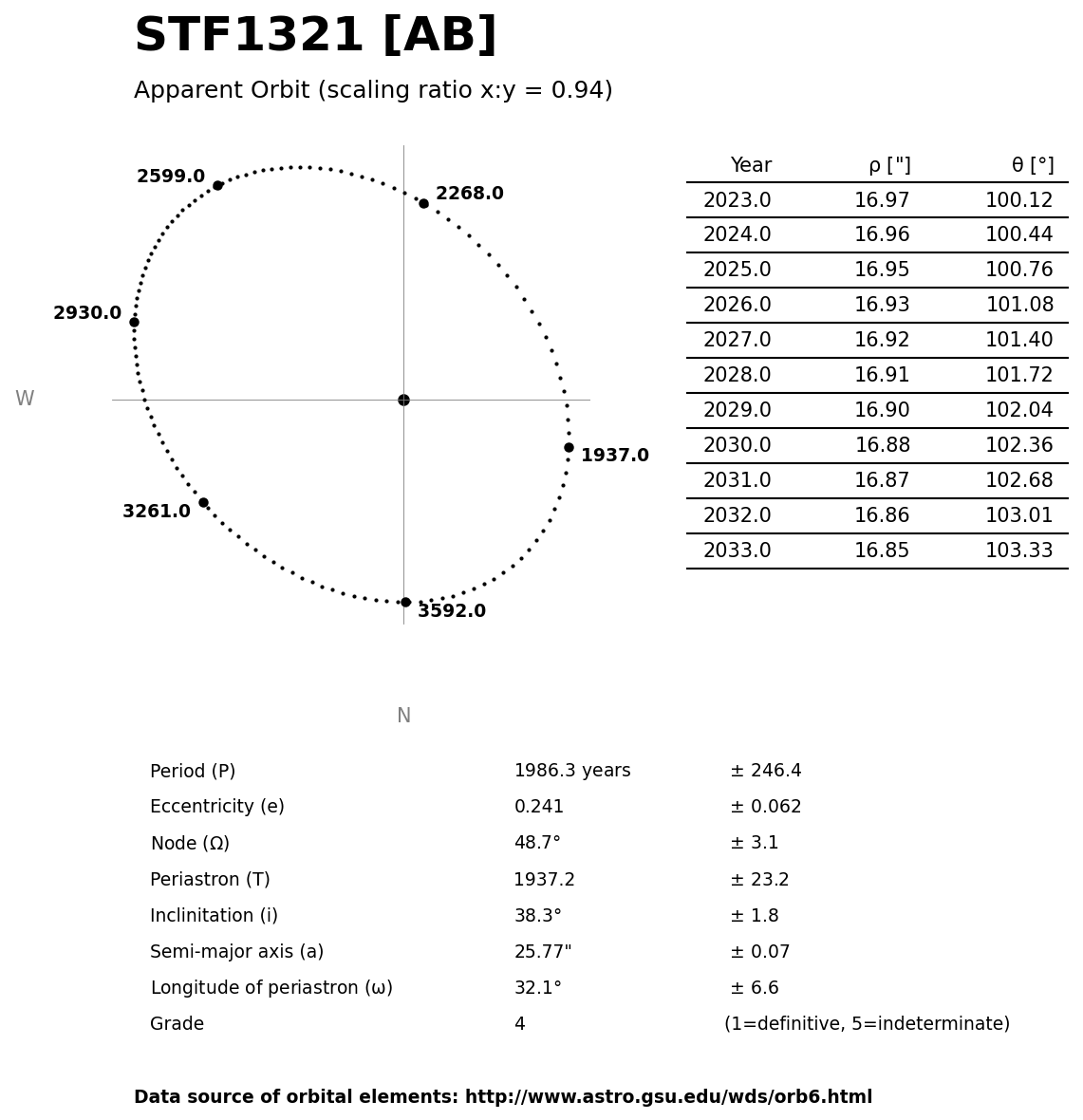
|
|
| Robert Zebahl |
B 16x70, Bortle 7, SQM-L 18.6
AB: 2020-07-05: Very nice view, striking, easily separable. A slight difference in brightness is visible. At first glance the double star appeared noticeably orange compared to the surrounding stars, on closer look a color difference of the two components was visible: orange & rather white.
|
|
70mm f/5.7, 22x, Bortle 6
AB: 2020-04-11: At 22x pretty wide pair with equally bright components. Striking colors: slightly orange & white-bluish, but it was a bit difficult to assign the colors to the components. At 44x slightly better color perception.
|
|
70mm f/5.7, 31x, Bortle 6, SQM-L 19.6
AB: 2020-04-19: Together with STF1312 in one field of view. At 22x very nice sight, easy to separate, attractive separation. Immediately apparent. A color difference is visible: dark yellow, orange. Also beautiful to see at 44x. Best view at 31x.
|
|
| René Merting |
76mm f/7.5, 29x, SQM-L 19.4
bei 29x ein wunderschön eng stehendes Sternpaar - bei beiden Sternen fällt sofort auf, dass sie nicht weiß sind - der westliche Stern strahlt intensiver, aber ein genauer Farbeindruck lässt sich nicht festmachen
|
|
|
STF 1331 (**)
|
| Name: |
STF1331 |
| Type: |
** |
| Constellation: |
UMa |
| Coordinates: |
09h20m46.02s / +61°20'58.40" |
| Components: |
|
|
m1 |
m2 |
ρ |
θ |
Year |
|
AB |
8m.5 |
8m.7 |
0.9" |
152° |
2021 |
|
AC |
8m.5 |
11m.6 |
13.5" |
186° |
2015 |
|
AD |
8m.5 |
14m.5 |
19.4" |
117° |
2015 |
|
AE |
8m.5 |
9m.8 |
139.1" |
223° |
2015 |
|
| Robert Zebahl |
152mm f/5.9, 180x, Bortle 6, SQM-L 19.4
2020-04-13: The wide pair AE is already visible at 22x with a significant difference in brightness, but quite inconspicuous. A appeared white-yellowish, E rather orange. The close pair AB appeared immediately elongated at 129x, partly visible as '8'. At 180x, AB was just separated with a fine black space between them. The faint C component was only visible with averted vision. Best view at 180x. The even fainter D component was out of range.
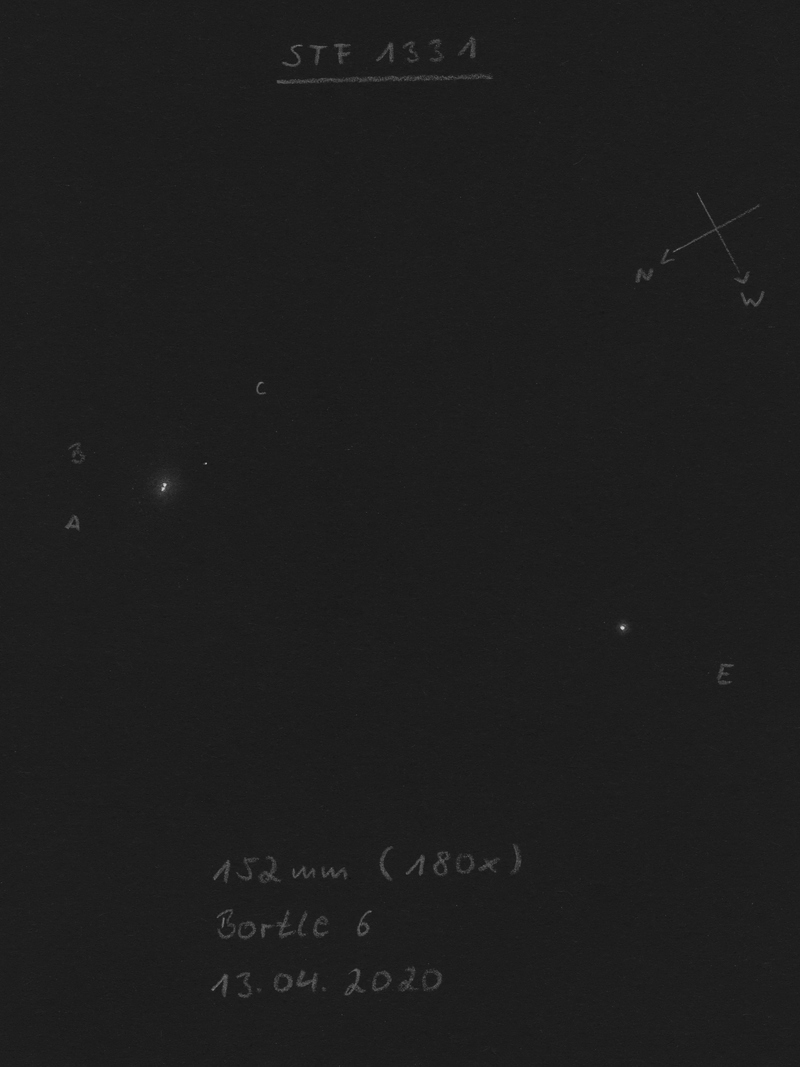
|
|
|
STF 1346 (**)
|
| Name: |
STF1346 |
| Type: |
** |
| Constellation: |
UMa |
| Coordinates: |
09h25m37.88s / +54°00'57.50" |
| Components: |
|
|
m1 |
m2 |
ρ |
θ |
Year |
|
AB |
7m.7 |
8m.6 |
5.7" |
314° |
2021 |
|
BC |
8m.6 |
11m.8 |
93.9" |
188° |
2015 |
|
| Robert Zebahl |
70mm f/5.7, 44x, Bortle 6, SQM-L 19.6
AB: 2020-04-19: At 31x very tight with clear difference in brightness. At 44x very fine separation. Component A appeared creamy white, B partly slightly orange.
|
|
|
STF 1349 (**)
|
| Name: |
STF1349 |
| Type: |
** |
| Constellation: |
UMa |
| Coordinates: |
09h31m09.89s / +67°32'28.40" |
| Components: |
|
|
m1 |
m2 |
ρ |
θ |
Year |
|
|
7m.5 |
9m.0 |
19.2" |
166° |
2015 |
|
| Robert Zebahl |
70mm f/5.7, 22x, Bortle 6, SQM-L 19.6
2020-04-19: At 22x easy to separate with significant difference in brightness. The primary component appears whitish, the companion darker. At 44x, the primary component looks rather white-yellowish, the companion greyish.
|
|
| René Merting |
B 18x70, SQM-L 21.0
einfacher als der benachbarte Doppelstern STF 1350 - ordentlich getrennt - Komponente B ist 1 bis 1.5 Größenklassen schwächer
|
|
100mm f/6.4, 32x, SQM-L 21.0
bei 32x stehen beide Sterne bequem getrennt auseinander - Komponente B im Süden ist eine knappe Größenklasse schwächer und kupfergrau - ein schönes Doppel-Doppel zusammen mit STF1350 gut 47' weiter südsüdöstlich
|
|
12.5" f/4.5, 45x, SQM-L 21.0
bei 45x steht das Pärchen gut auseinander - Komponente B ist eine dreiviertel Größenklasse schwächer und wirkt grauweiß - A ist weiß mit einem zarten Stich ins Gelbe
|
|
|
STF 1350 (**)
|
| Name: |
STF1350 |
| Type: |
** |
| Constellation: |
UMa |
| Coordinates: |
09h34m19.56s / +66°47'42.30" |
| Components: |
|
|
m1 |
m2 |
ρ |
θ |
Year |
|
AB |
8m.3 |
8m.3 |
10.3" |
69° |
2021 |
|
AC |
8m.3 |
9m.2 |
131.0" |
216° |
2015 |
|
| Robert Zebahl |
70mm f/5.7, 22x, Bortle 6, SQM-L 19.6
2020-04-19: At 22x A & B equally bright and still pretty close together. Component C is visible at a much greater distance. At 44x, A & B show a color difference: orange, white-bluish.
|
|
152mm f/5.9, 100x, Bortle 6-, SQM-L 19.1
At 22x, all three components are already visible, with A & B still standing quite close together. Component C is less prominent. At 69x and 100x, the pair AB shows a nice color contrast: The eastern component mostly appeared in a slightly shiny orange, while the other component appeared more white-bluish. During the observation, however, the colors changed between both components. At the time of observation, the pretty bright comet C/2019 Y4 Atlas was also in the same field of view - a great scene! Note to the sketch: The positions of the stars to each other do not exactly match, also the alignment of the pair AB to C.
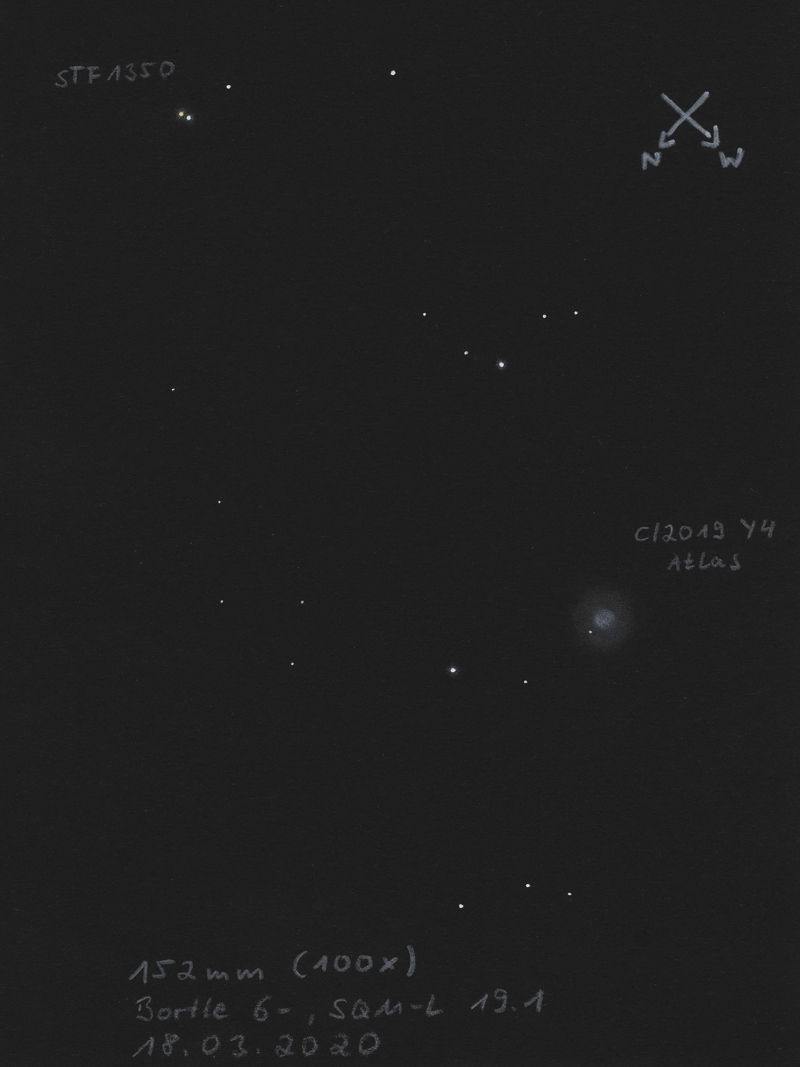
|
|
| René Merting |
B 18x70, SQM-L 21.0
AB: ein sehr enger Doppelstern, äußerst knapp getrennt … und das auch nur in guten Momenten, ansonsten wirkt das Paar wie eine Ameise - beide Sterne sind gleich hell - ein FG-Tester für 18x
|
|
100mm f/6.4, 32x, SQM-L 21.0
AB: bei 32x ein schönes enges Paar zweier gleich heller Sterne, knapp getrennt - STF1350 AB bildet mit vier ähnlich hellen Sternen westlich ein Muster, ähnlich einer Sense
AC: bei 32x bildet STF1350 AB mit vier ähnlich hellen Sternen westlich ein Muster, ähnlich einer Sense - der erste der vier Sterne bzw. der nächststehende Stern südsüdwestlich mit mehr als zehnfachem Abstand AB ist Komponente C, er ist schätzungsweise eine halbe Größenklasse schwächer
|
|
12.5" f/4.5, 45x, SQM-L 21.0
AB: bei 45x ein schönes enges Paar zweier gleich heller Sterne, beide strahlen weiß
|
|
|
STF 1351 (**)
|
| Name: |
STF1351, 23 UMa |
| Type: |
** |
| Constellation: |
UMa |
| Coordinates: |
09h31m31.57s / +63°03'42.50" |
| Components: |
|
|
m1 |
m2 |
ρ |
θ |
Year |
|
AB |
3m.6 |
9m.2 |
22.7" |
267° |
2016 |
|
AC |
3m.7 |
11m.8 |
107.4" |
232° |
2015 |
|
| Robert Zebahl |
70mm f/5.7, 22x
AB: 2020-04-07: Well separable with a significant difference in brightness, where the companion appearing only as a tiny star close to the primary component. The primary component itself appeared bright and rather whitish.
|
|
| René Merting |
76mm f/7.5, 57x, SQM-L 19.4
AB: bei 57x zeigt sich Komponente B sehr schwach westlich von A, schon ordentlich weit abgesetzt - B ist nadelfein und mausgrau - Helligkeitsunterschied gut 3 Magnituden, wenn nicht sogar mehr
|
|
100mm f/6.4, 32x, SQM-L 21.0
AB: bei 32x ist A gleißend, B im Westen extrem schwacher Lichtpunkt, gut 4-5 Größenklassen schwächer - bei 64x kann ich A ein wenig gebändigt erkennen und hat einen leichten Stich ins Gelbliche, B ist ordentlich abgesetzt
|
|
107mm f/5.6, 30x, SQM-L 21.0
AB: ein herrliches Beispiel für ein sehr ungleiches Paar - bei 30x strahlt A leicht ockergelb, B zeigt sich ordentlich abgesetzt als kleiner, feiner, nicht ganz grauer Punkt, sondern mehr weißlich
|
|
12.5" f/4.5, 45x, SQM-L 21.0
AB: bei 45x ist Komponente B schwach sichtbar neben dem gelblich strahlenden 23 UMa - großer nicht abschätzbarer Helligkeitsunterschied
|
|
|
STF 1400 (**)
|
| Name: |
STF1400 |
| Type: |
** |
| Constellation: |
UMa |
| Coordinates: |
10h02m56.49s / +68°47'09.30" |
| Components: |
|
|
m1 |
m2 |
ρ |
θ |
Year |
|
AB |
8m.0 |
9m.8 |
3.5" |
221° |
2021 |
|
| René Merting |
107mm f/5.6, 120x, SQM-L 21.1
Vergrößerungen bis 120x, aber in der Nacht keine Chance auf eine Trennung, die theoretisch aber möglich ist
|
|
|
STF 1402 & GIR 2 & TDS 7005 (**)
|
| Name: |
STF1402 & GIR2 & TDS7005 |
| Type: |
** |
| Constellation: |
UMa |
| Coordinates: |
10h04m54.93s / +55°29'16.50" |
| Components: |
|
|
m1 |
m2 |
ρ |
θ |
Year |
| STF1402 |
AB |
7m.9 |
8m.9 |
33.1" |
105° |
2015 |
| GIR2 |
AC |
7m.9 |
9m.7 |
132.3" |
175° |
2015 |
| TDS7005 |
CD |
10m.4 |
10m.4 |
1.2" |
259° |
2016 |
|
| René Merting |
107mm f/5.6, 30x, SQM-L 21.0
STF 1402: bei 30x zeigt sich ein mehr als ordentlich getrenntes Pärchen mit einem schönen Farbkontrast, A wirkt Weiß, mit rotorangen Farbanteilen, B dagegen strahlt Blaugrau - Helligkeitsunterschied eine Magnitude - auch bei 43x wirkt die Farbe von A eigentümlich, ein helles Lachsorange trifft es am besten, die B-Komponente strahlt weiter stur in Blaugrau
GIR 2: bei 43x zeigt sich etwas weiter südlich in 3- bis 4-fachem Abstand ein Sternchen, nämlich Komponente C, etwa halb so hell wie B
|
|
|
STF 1415 (**)
|
| Name: |
STF1415 |
| Type: |
** |
| Constellation: |
UMa |
| Coordinates: |
10h17m50.61s / +71°03'38.90" |
| Components: |
|
|
m1 |
m2 |
ρ |
θ |
Year |
|
AB |
6m.7 |
7m.3 |
16.6" |
167° |
2024 |
|
AC |
6m.7 |
10m.8 |
153.3" |
13° |
2015 |
|
| Robert Zebahl |
B 16x70, Bortle 4, SQM-L 21.0
AB: 2022-03-27: Beautiful double star, bright, conspicuous with small difference in brightness. The components appeared yellowish-orange and white-bluish.
|
|
70mm f/5.7, 22x
AB: 2020-04-07: At 22x immediately noticeable as double star, medium bright with rather small difference in brightness. A appeared whitish, B slightly orange, partly brownish. At 44x similar color impression: A white-bluish, B slightly orange.
|
|
70mm f/5.7, 44x, Bortle 6, SQM-L 19.2
AB: 2021-04-03: At 12x easily separated, moderate brightness difference, unspectacular. At 44x, A appeared pale yellowish, B in very light blue. The color contrast was very subtle.
|
|
| René Merting |
12.5" f/4.5, 45x, SQM-L 21.0
AB: bei 45x ein eng stehendes ordentlich getrenntes Paar - Komponente B im Süden wirkt weißgrau gegen die gut eine halbe Größenklasse hellere A-Komponente - das Paar sieht schick aus, es wird von drei schwächeren Sternen umrahmt
|
|
|
STF 1427 (**)
|
| Name: |
STF1427 |
| Type: |
** |
| Constellation: |
UMa |
| Coordinates: |
10h22m00.53s / +43°54'19.30" |
| Components: |
|
|
m1 |
m2 |
ρ |
θ |
Year |
|
|
8m.2 |
8m.5 |
9.2" |
214° |
2024 |
|
| Robert Zebahl |
70mm f/5.7, 22x, Bortle 6, SQM-L 19.6
2020-04-19: At 22x very fine separated, but still tight. A very small difference in brightness was visible. At 44x also a nice view. In both magnifications I could see color differences: pale orange, grey-blue.
|
|
|
STF 1460 (**)
|
| Name: |
STF1460 |
| Type: |
** |
| Constellation: |
UMa |
| Coordinates: |
10h40m35.04s / +42°09'11.60" |
| Components: |
|
|
m1 |
m2 |
ρ |
θ |
Year |
|
|
8m.7 |
8m.9 |
3.9" |
161° |
2019 |
|
| Robert Zebahl |
70mm f/5.7, 57x, Bortle 6, SQM-L 19.6
2020-04-19: At 44x clearly visible as '8', overall quite faint and almost separated. The components seemed equally bright. At 57x separated, equally bright.
|
|
|
STF 1486 (**)
|
| Name: |
STF1486 |
| Type: |
** |
| Constellation: |
UMa |
| Coordinates: |
10h55m01.14s / +52°07'18.20" |
| Components: |
|
|
m1 |
m2 |
ρ |
θ |
Year |
|
|
8m.4 |
9m.7 |
31.6" |
100° |
2024 |
|
| René Merting |
100mm f/6.4, 20x, SQM-L 21.0
bei 32x einfach, ordentliche Trennung - Komponente B im Osten ist halb so hell wie A - eigenartiger Farbkontrast, B wie so oft grau, aber A ist orangebraun - zurück auf 20x sind beide Sterne auch noch gut getrennt erkennbar
|
|
|
STF 1495 (**)
|
| Name: |
STF1495 |
| Type: |
** |
| Constellation: |
UMa |
| Coordinates: |
10h59m49.47s / +58°54'23.30" |
| Components: |
|
|
m1 |
m2 |
ρ |
θ |
Year |
|
|
7m.2 |
8m.8 |
33.6" |
36° |
2024 |
|
| Robert Zebahl |
B 16x70, Bortle 6-, SQM-L 19.0
2023-02-15: Very pretty. The primary component shines in a light orange, the much fainter, nicely separated companion appears bluish.
|
|
| René Merting |
B 18x70, SQM-L 21.0
ein komfortabel getrenntes Sternpaar mit leichtem Farbkontrast - B steht versetzt nördlich von A und ist 1.5 bis 2 Magnituden schwächer
|
|
76mm f/7.5, 29x, SQM-L 19.4
bei 29x einfach zu trennen - bei 57x wirkt A auf den Punkt genau gelb, starker Farbkontrast zur B-Komponente, die graublau wirkt
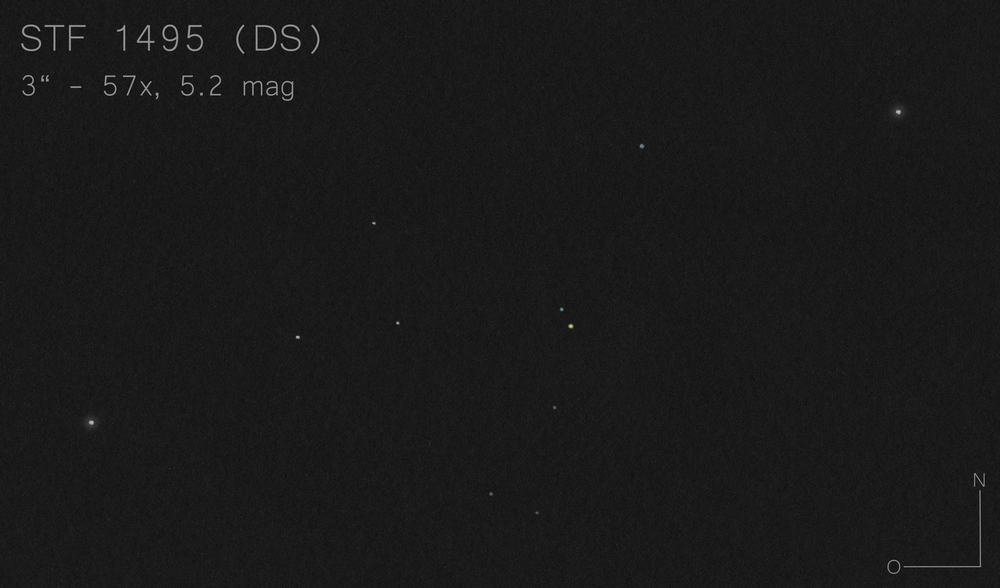
|
|
100mm f/6.4, 20x, SQM-L 21.0
bei 32x ein weit getrenntes Paar - Komponente B im NO ist knapp zwei Magnituden schwächer - A strahlend weiß, B die graue Maus, wie es sich gehört für die schwächere Komponente - zurück auf 20x immernoch ordentliche Trennung, der Helligkeitsunterschied wirkt nicht mehr ganz so groß
|
|
12.5" f/4.5, 45x, SQM-L 21.0
bei 45x weit getrennt - ein schönes farbiges Kontrastpaar - Komponente B im NO ist gut 1.5 Größenklassen schwächer und strahlt kupfergrau, A dagegen ist weißgelb
|
|
|
STF 1505 (**)
|
| Name: |
STF1505 |
| Type: |
** |
| Constellation: |
UMa |
| Coordinates: |
11h05m41.23s / +62°37'01.50" |
| Components: |
|
|
m1 |
m2 |
ρ |
θ |
Year |
|
AB |
8m.9 |
10m.6 |
8.1" |
312° |
2024 |
|
AC |
8m.9 |
12m.0 |
217.7" |
177° |
2015 |
|
| Robert Zebahl |
70mm f/5.7, 80x, Bortle 6, NELM 5m.0+
AB: 2020-04-14: Easy split with pretty dim companion.
|
|
|
STF 1510 (**)
|
| Name: |
STF1510 |
| Type: |
** |
| Constellation: |
UMa |
| Coordinates: |
11h08m00.06s / +52°49'17.90" |
| Components: |
|
|
m1 |
m2 |
ρ |
θ |
Year |
|
|
7m.7 |
9m.0 |
5.5" |
328° |
2024 |
|
|
|
|
|

|
|
| René Merting |
100mm f/6.4, 64x, SQM-L 21.0
bei 32x wirkt der Stern leicht länglich - bei 64x dann gelingt die Trennung - Komponente B hängt nordwestlich über A und ist mehr als eine Größenklasse schwächer - ein schönes enges Paar bei dieser Vergrößerung - B wirkt trotz des Größenunterschiedes nicht so schmutzig grau, wie es sonst immer ist
|
|
|
STF 1520 (**)
|
| Name: |
STF1520 |
| Type: |
** |
| Constellation: |
UMa |
| Coordinates: |
11h16m04.03s / +52°46'23.40" |
| Components: |
|
|
m1 |
m2 |
ρ |
θ |
Year |
|
|
6m.5 |
7m.8 |
12.2" |
343° |
2024 |
|
| Robert Zebahl |
B 16x70, Bortle 4, SQM-L 21.0
2022-03-27: Pretty view of the tightly separated components with a clear difference in brightness. A appears white, B on the other hand orange-brownish.
|
|
70mm f/5.7, 44x
2020-04-08: At 22x pretty tight, uneven pair. A appeared orange, B did not show any clear color. At 44x, A appeared yellowish-orange, B silvery grey, partly grey-bluish.
|
|
| René Merting |
B 18x70, SQM-L 21.0
ideal für 18x, ein schönes enges Sternpaar - Komponente B prangt nordöstlich von A ganz knapp getrennt und wirkt gut 1.5 Größenklassen schwächer - beide haben eine reinweiße Weste, was ungewöhnlich ist ob des großen Helligkeitsunterschiedes
|
|
100mm f/6.4, 20x, SQM-L 21.0
bei 32x ein knapp getrenntes Pärchen, auffällig im Umfeld - Komponente B ist eine Größenklasse schwächer - zurück auf 20x noch schönerer Eindruck, beider Sterne können noch ganz knapp getrennt voneinander gesehen werden
|
|
|
STF 1523 (**)
|
| Name: |
STF1523, xi UMa, 53 UMa, Alula Australis |
| Type: |
** |
| Constellation: |
UMa |
| Coordinates: |
11h18m10.90s / +31°31'45.00" |
| Components: |
|
|
m1 |
m2 |
ρ |
θ |
Year |
|
AB |
4m.3 |
4m.8 |
3.3" |
137° |
2024 |
|
|
|
|
|

|
|
| Robert Zebahl |
55mm f/9.1, 83x, Bortle 6-, SQM-L 19.1
2019-02-09: Already seen as '8' at 83x. At 125x the overlapping of both Airy disks was visible, but also a slight difference in brightness.

|
|
70mm f/5.7, 100x, Bortle 6
2018-02-18: Very close together with similar brightness. At first glance seen as an '8', looking closer I partly split both components. Similar view also at 128x.
|
|
70mm f/5.7, 133x
2020-03-15: Splendid sight! Beautifully separated with almost touching diffraction disks. The rather small difference in brightness was well visible. The diffraction rings of both components coalesced.
|
|
102mm f/11, 160x
2020-03-16: Awesome! Bright with lovely, subtle diffraction rings. The distance between both components is a smaller than the diameter of the diffraction disk of the fainter component.
|
|
120mm f/5, 168x, Bortle 6, SQM-L 19.1
2018-02-14: Well split with slight difference in brightness.
|
|
152mm f/5.9, 129x, Bortle 6, NELM 5m.0+
2019-02-06: Well split with visible difference in brightness. The colors of both components appeared equal.
|
|
|
STF 1544 (**)
|
| Name: |
STF1544 |
| Type: |
** |
| Constellation: |
UMa |
| Coordinates: |
11h31m18.57s / +59°42'03.30" |
| Components: |
|
|
m1 |
m2 |
ρ |
θ |
Year |
|
|
7m.3 |
8m.0 |
12.2" |
92° |
2022 |
|
| Robert Zebahl |
B 16x70, Bortle 6-, SQM-L 19.0
2023-02-15: Well separated, but still relatively close pair. Colorwise not conspicuous.
|
|
70mm f/5.7, 22x, Bortle 6, SQM-L 19.6
2020-04-19: At 22x beautifully separated, moderately bright with visible difference in brightness. The components are still quite close together and appear white-bluish and slightly orange. At 31x same color impression.
|
|
| René Merting |
100mm f/6.4, 32x, SQM-L 21.0
bei 32x der Prototyp des idealtypischen engen Doppelsternpaares - zwei schön aneinander geschmiegte Sterne, knapp getrennt - Komponente B im Osten ist eine halbe Größenklasse schwächer
|
|
12.5" f/4.5, 72x, SQM-L 21.0
bei 72x ein gut getrenntes helles Pärchen - Komponente B ist maximal eine Dreiviertel Größenklasse schwächer - A strahlt chremeweiß, B kühler in der Ausstrahlung, deswegen ist ein kleiner feiner Farbkontrast erkennbar
|
|
|
STF 1546 (**)
|
| Name: |
STF1546 |
| Type: |
** |
| Constellation: |
UMa |
| Coordinates: |
11h32m20.34s / +56°05'43.30" |
| Components: |
|
|
m1 |
m2 |
ρ |
θ |
Year |
|
|
7m.5 |
10m.3 |
11.5" |
350° |
2022 |
|
| Robert Zebahl |
70mm f/5.7, 31x, Bortle 6, SQM-L 19.6
2020-04-19: Separated with a clear difference in brightness - the companion was rather dim. The primary component appeared creamy white.
|
|
|
STF 1553 (**)
|
| Name: |
STF1553 |
| Type: |
** |
| Constellation: |
UMa |
| Coordinates: |
11h36m35.69s / +56°08'07.30" |
| Components: |
|
|
m1 |
m2 |
ρ |
θ |
Year |
|
|
7m.7 |
8m.2 |
6.2" |
165° |
2019 |
|
|
|
|
|
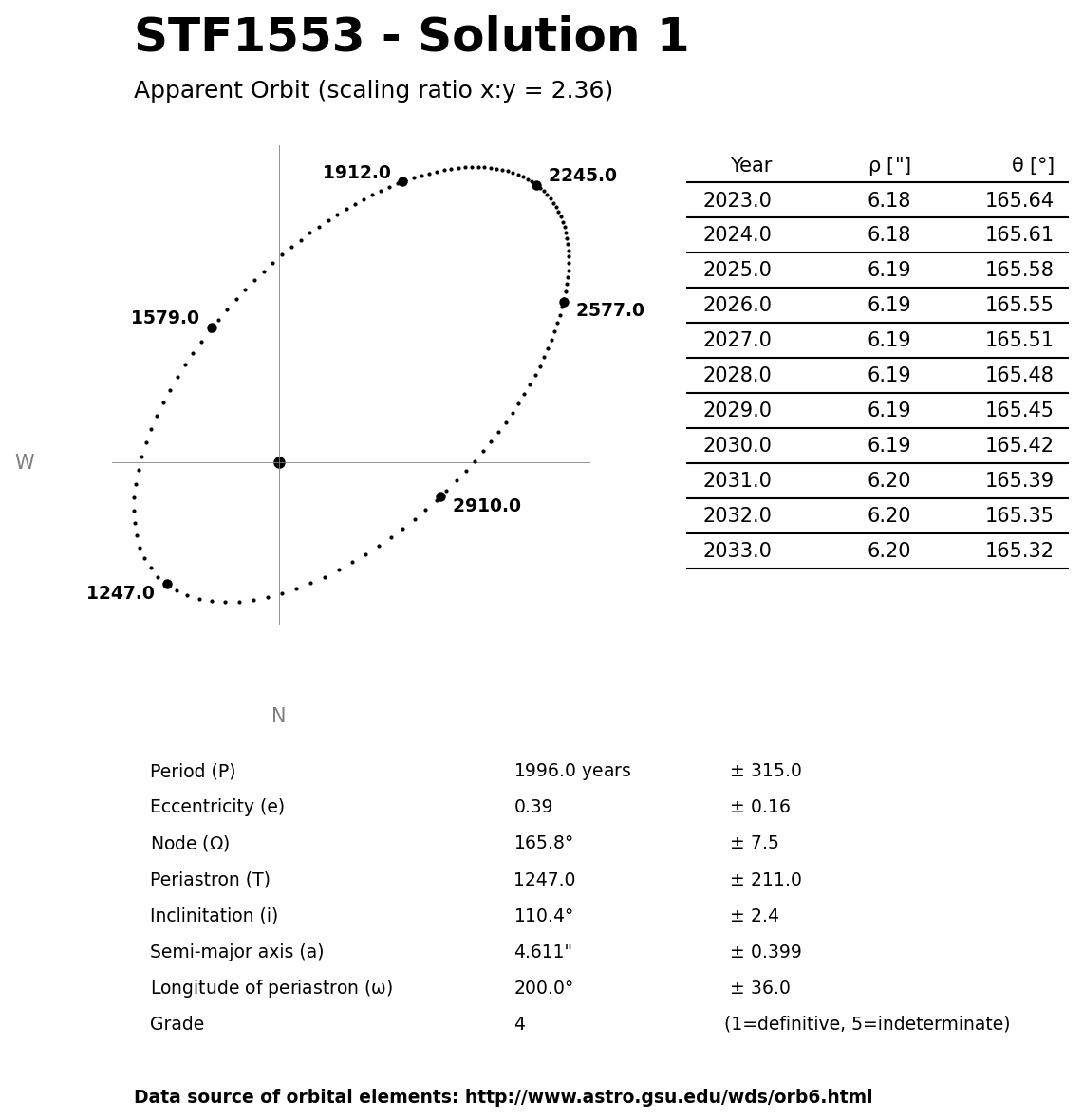
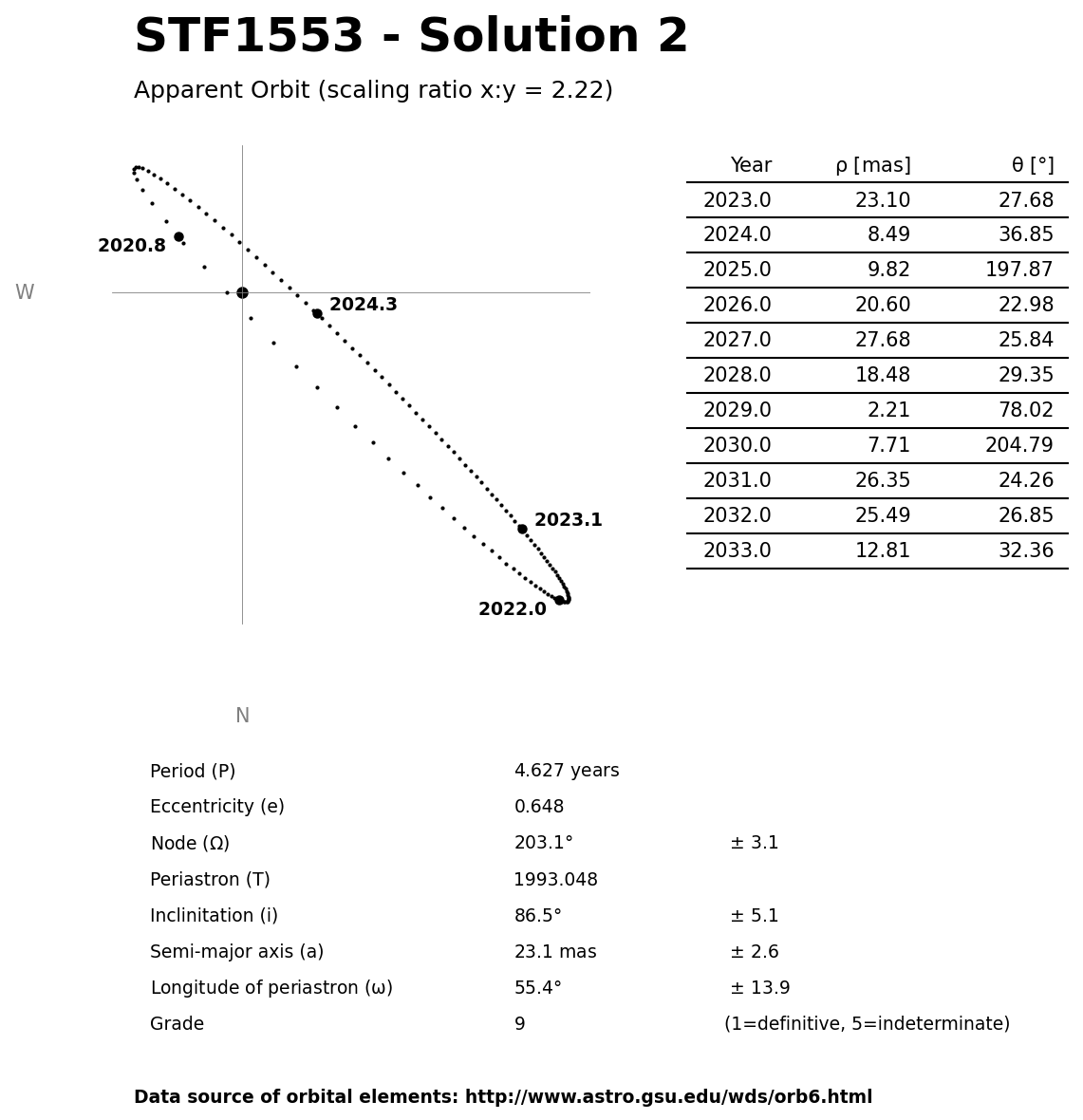
|
|
| Robert Zebahl |
B 16x70, Bortle 6-, SQM-L 19.0
2023-02-15: Immediately recognizable as figure '8', occasionally almost separated.
|
|
70mm f/5.7, 31x, Bortle 6, SQM-L 19.6
2020-04-19: At 22x medium bright double star with apparently similar bright components. At first sight visible as '8', on closer look separated. At 31x very fine split of the components with small difference in brightness. The two components appeared yellowish and slightly orange.
|
|
| René Merting |
B 18x70, SQM-L 21.0
der Doppelstern zeigt sich länglich, aber nicht getrennt - die Einschnürung ist auch nur zu erahnen, aber man sieht auf jeden Fall, dass dort kein Einzelstern steht
|
|
12.5" f/4.5, 45x, SQM-L 21.0
bei 45x sehe ich zwei fast gleich helle Sterne ganz eng beieinander stehen, da passt sprichwörtlich kein Blatt Papier dazwischen - bei 72x Helligkeitsunterschied eine knappe halbe Magnitude - ein ganz feiner Farbunterschied, Komponente A leicht weißgelblich, B im Osten wirkt ein bisschen grau
|
|
|
STF 1559 (**)
|
| Name: |
STF1559 |
| Type: |
** |
| Constellation: |
UMa |
| Coordinates: |
11h38m49.11s / +64°20'49.40" |
| Components: |
|
|
m1 |
m2 |
ρ |
θ |
Year |
|
|
6m.8 |
8m.0 |
2.0" |
326° |
2019 |
|
| Robert Zebahl |
70mm f/5.7, 133x, Bortle 6, NELM 5m.0+
2020-04-14: Two clearly visible, slightly touching diffraction disks. The fainter companion appeared somewhat more diffuse. Occasionally the double star appeared separated.
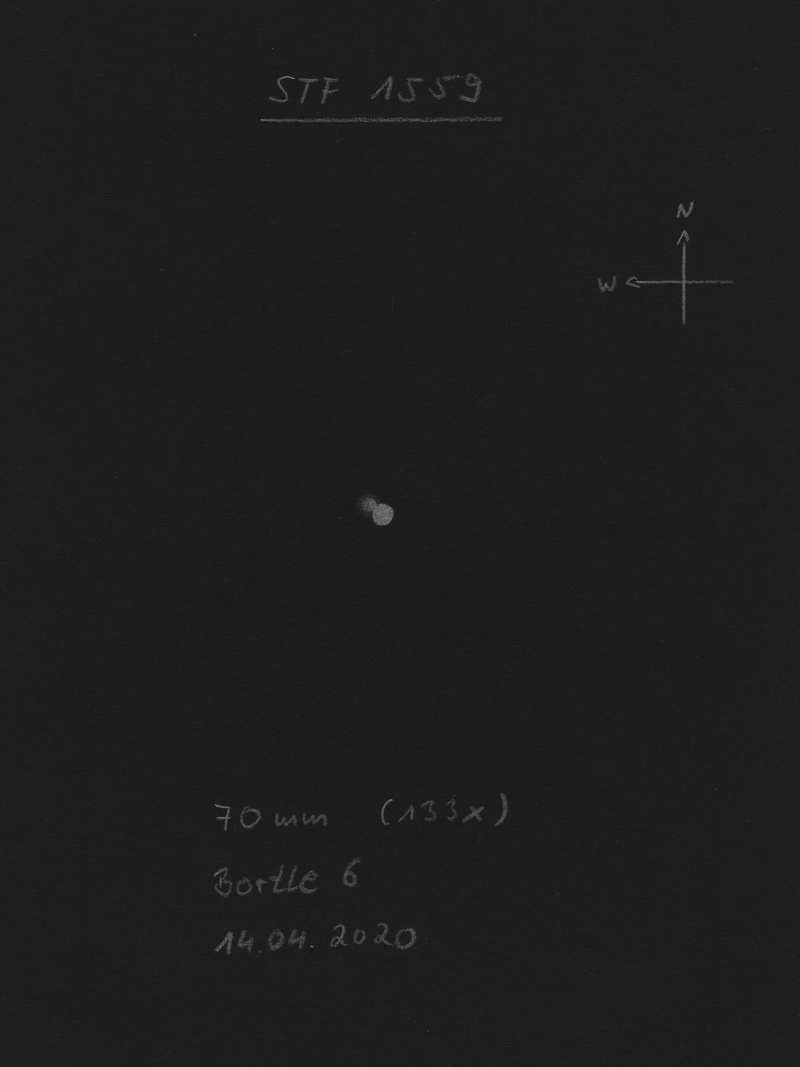
|
|
|
STF 1561 (**)
|
| Name: |
STF1561 |
| Type: |
** |
| Constellation: |
UMa |
| Coordinates: |
11h38m44.90s / +45°06'30.30" |
| Components: |
|
|
m1 |
m2 |
ρ |
θ |
Year |
|
AB |
6m.5 |
8m.2 |
8.8" |
245° |
2021 |
|
AC |
6m.5 |
9m.5 |
176.8" |
90° |
2015 |
|
AD |
6m.5 |
7m.6 |
718.2" |
76° |
2015 |
|
AE |
6m.5 |
12m.1 |
60.7" |
338° |
2015 |
|
|
|
|
|

|
|
| Robert Zebahl |
70mm f/5.7, 44x
AB: 2020-04-07: At 22x separated. The fainter companion is still very close to the primary component. At 44x beautiful sight with a clear difference in brightness. A: slightly yellowish, B: pale bluish.
|
|
70mm f/5.7, 31x, Bortle 6, SQM-L 19.6
AB: 2020-04-19: At 22x separated, but relatively tight together with significant difference in brightness. The pair stands close to 2 medium bright stars. Both components appear white. At 31x beautiful sight, the color of the components looks slightly different: white-yellowish with darker ( slightly orange?) companion.
|
|
|
STF 1579 (**)
|
| Name: |
STF1579, 65 UMa |
| Type: |
** |
| Constellation: |
UMa |
| Coordinates: |
11h55m05.74s / +46°28'36.60" |
| Components: |
|
|
m1 |
m2 |
ρ |
θ |
Year |
|
AB-C |
6m.7 |
8m.3 |
3.8" |
43° |
2023 |
|
AB-D |
6m.7 |
7m.0 |
62.9" |
114° |
2021 |
|
| Robert Zebahl |
55mm f/9.1, 83x, Bortle 6-, SQM-L 19.1
2019-02-09: AB, C & D easy to split, but the faint C component only appeared as a tiny star. To the south there is the brighter D component.
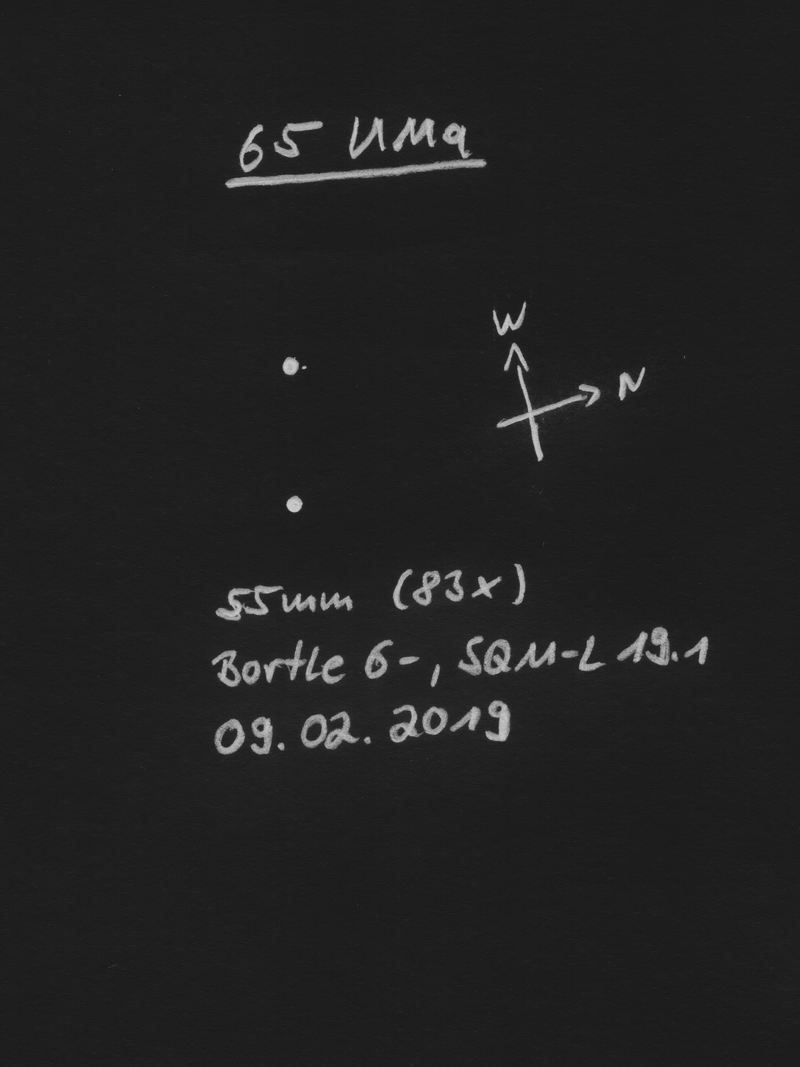
|
|
B 8x40
AB-D: 2020-04-05: Immediately conspicuous in the field. Medium bright double star with slightly uneven components. Western component AB appeared slightly orange, component D tended to be bluish.
|
|
55mm f/9.1, 27x, Bortle 6-, SQM-L 19.1
AB-D: Easy to separate with large distance and very small difference in brightness. The D component showed a bluish tint, the lighter one (AB) a slightly yellowish tint. At higher magnification also the faint C component is visible.
|
|
|
STF 1600 (**)
|
| Name: |
STF1600 |
| Type: |
** |
| Constellation: |
UMa |
| Coordinates: |
12h05m34.42s / +51°55'52.20" |
| Components: |
|
|
m1 |
m2 |
ρ |
θ |
Year |
|
|
7m.6 |
8m.3 |
7.6" |
93° |
2024 |
|
| Robert Zebahl |
70mm f/5.7, 44x, Bortle 6, SQM-L 19.6
2020-04-19: Uneven pair. At 22x medium bright and still pretty tight. At 44x beautiful sight: pale orange, grey-bluish.
|
|
|
STF 1603 (**)
|
| Name: |
STF1603 |
| Type: |
** |
| Constellation: |
UMa |
| Coordinates: |
12h08m07.07s / +55°27'50.70" |
| Components: |
|
|
m1 |
m2 |
ρ |
θ |
Year |
|
AB |
7m.8 |
8m.3 |
22.3" |
85° |
2023 |
|
| Robert Zebahl |
B 16x70, Bortle 4, SQM-L 21.0
2022-03-27: Medium bright at moderate separation and slight difference in brightness. Slight color difference: yellowish & slightly bluish.
|
|
70mm f/5.7, 22x
2020-04-07: At 22x quite apparent double star in rather poor surrounding. Nice separation with little difference in brightness. Primary component appeared slightly orange, companion grey-bluish. At 44x similar view in color appearance.
|
|
| René Merting |
B 18x70, SQM-L 21.0
ein Sternpaar, das zu gefallen weiß, etwas mehr als knapp getrennt - B im Nordosten wirkt eine viertel Größenklasse schwächer - leichter Farbunterschied, wobei B Zartorange, Braunweiß, Ockergrau oder so wirkt, naja
|
|
12.5" f/4.5, 45x, SQM-L 21.0
bei 45x gut getrennt - Komponente B im Osten wirkt grauorange gegen die weiß strahlende Komponente A - Helligkeitsunterschied eine halbe Größenklasse - ein schön isoliert stehendes Sternpaar
|
|
|
STF 1608 (**)
|
| Name: |
STF1608 |
| Type: |
** |
| Constellation: |
UMa |
| Coordinates: |
12h11m27.76s / +53°25'17.50" |
| Components: |
|
|
m1 |
m2 |
ρ |
θ |
Year |
|
AB |
8m.1 |
8m.3 |
13.5" |
221° |
2023 |
|
|
|
|
|
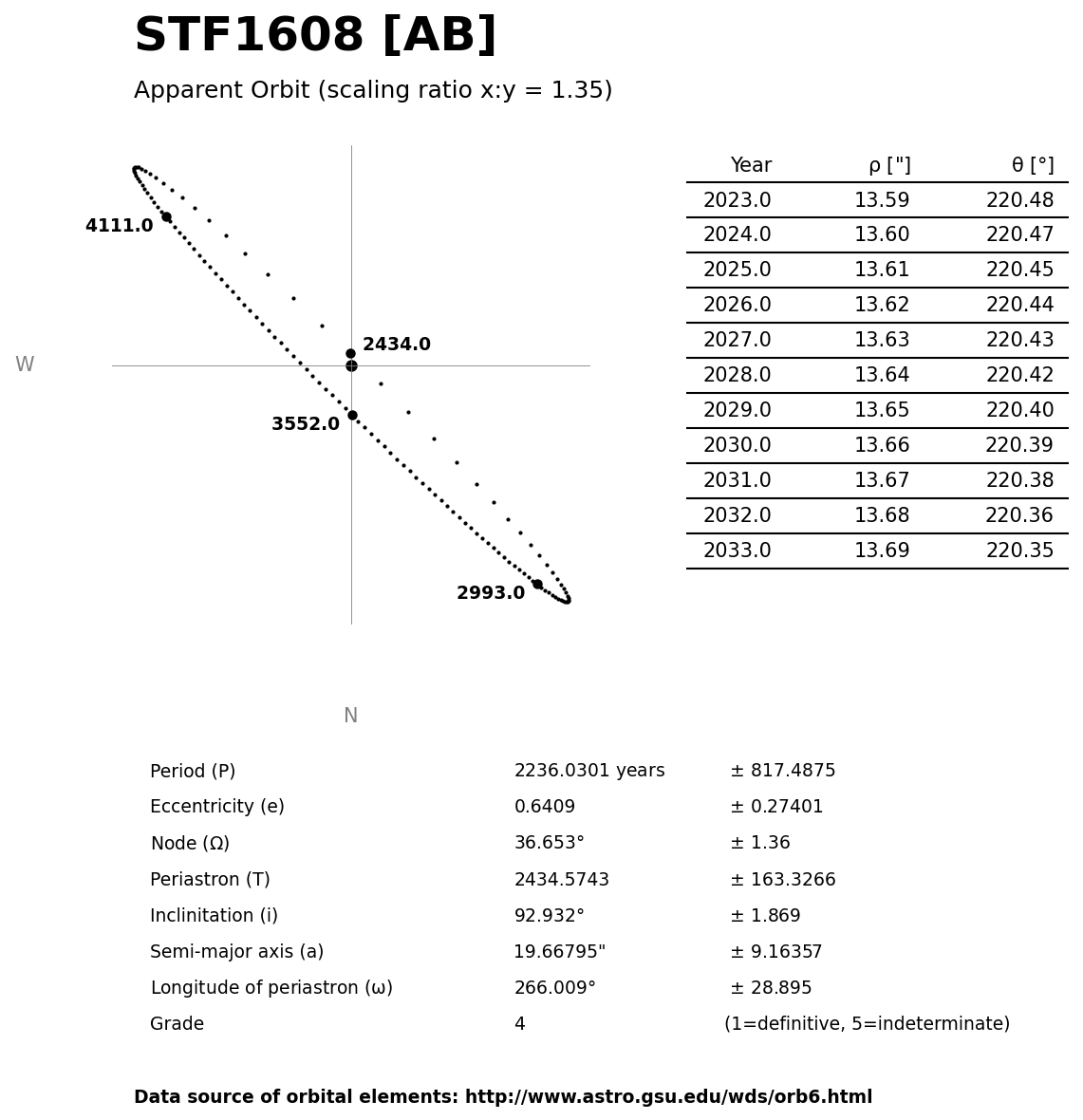
|
|
| Robert Zebahl |
70mm f/5.7, 22x, Bortle 6, SQM-L 19.6
2020-04-19: Easy to find, medium bright. At 22x quite conspicuous with rather small difference in brightness. A difference in color is clearly visible: slightly orange, white-bluish. At 31x nice color contrast with a little more intense colors: light orange & light blue.
|
|
| René Merting |
B 18x70, SQM-L 21.0
wie gemacht für 18x - ein Paar gleich heller Sterne, minimalst getrennt - B scheint im Südwesten zu stehen, der Stern ist nur minimal schwächer
|
|
12.5" f/4.5, 72x, SQM-L 21.0
bei 72x ein schönes helles Pärchen, beide Komponenten sind gleich hell und Zahncremeweiß
|
|
|
STF 1695 (**)
|
| Name: |
STF1695 |
| Type: |
** |
| Constellation: |
UMa |
| Coordinates: |
12h56m17.64s / +54°05'58.10" |
| Components: |
|
|
m1 |
m2 |
ρ |
θ |
Year |
|
AB |
6m.0 |
7m.8 |
3.7" |
280° |
2023 |
|
AC |
6m.0 |
12m.3 |
131.7" |
139° |
2015 |
|
| Robert Zebahl |
70mm f/5.7, 57x, Bortle 6-
AB: Easily separable, but still quite close together with a relatively large difference in brightness. The companion appeared only as a tiny star.
|
|
|
STF 1744 & SMR 4 (**)
|
| Name: |
STF1744 & SMR4, zeta UMa |
| Type: |
** |
| Constellation: |
UMa |
| Coordinates: |
13h23m55.42s / +54°55'31.50" |
| Components: |
|
|
m1 |
m2 |
ρ |
θ |
Year |
| STF1744, 79 UMa, Mizar |
AB |
2m.2 |
3m.9 |
14.4" |
153° |
2022 |
| STF1744, Mizar & Alcor |
AC |
2m.2 |
4m.0 |
715.5" |
73° |
2020 |
| SMR4 |
AD |
2m.2 |
7m.6 |
498.1" |
103° |
2020 |
|
| Robert Zebahl |
102mm f/11, 28x
First pastel sketch (Pitt pastel by Faber-Castell) of a double star on black paper, where also the halos were sketched around the stars. The stars themselves were redrawn with an Edding (Edding 1500, Soft Pastel white). The sketch shows the components A to D.
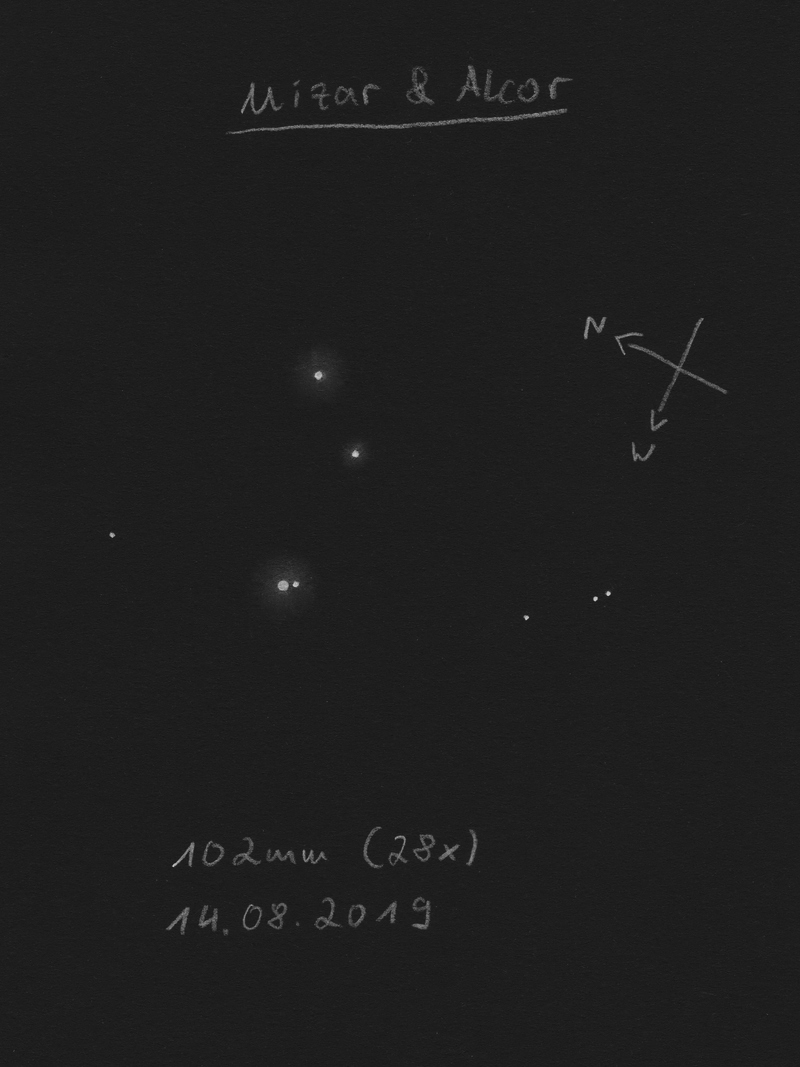
|
|
B 8x40
AB: 2020-04-05: Even with tripod not separable.
|
|
70mm f/5.7, 10x
AB: 2020-04-12: Observation from city with a 70/400mm ED refractor, for which I made aperture masks from 10mm to 60mm. Goal was to find the minimum magnification for a successful split.
70mm: At 12.5x no separation of the components possible due to outshining. Grey filters brought a slight improvement, but again no separation or elongation was visible.
60mm: At 12.5x slight outshining of the companion, clearly elongated and almost separated.
50mm: At 12.5x the companion was almost outshined. A separation was just possible.
40mm: At 12.5x both components appear finely separated from each other.
30mm: At 10x not clearly separable due to outshining, but clearly elongated. At 12.5x then quite easy to separate with a fine star rendition.
20mm: At 10x the companion is still clearly visible, but quite close to the primary component. At 12.5x best view under the used apertures with a very fine rendition!
10mm: At 10x the companion appears very faint. Separation possible, but extremely tight. At 12.5x reasonably well separated.
|
|
70mm f/5.7, 22x, Bortle 6
AB: 2020-04-11: At 12x no separation possible, because the bright primary component outshines the companion. At 22x clearly separated, but still quite close together.
|
|
| René Merting |
naked eye, SQM-L 21.4
AC: perfekte Bedingungen: der Doppelstern steht im Zenit, gute Transparenz … und siehe da, das kleine Reiterlein Komponente C ist zu erkennen, ach was sage ich, leicht zu erkennen - C ist deutlich schwächer, Trennung mehr als knapp - heute so einfach, wie oft bin ich im Vorfeld gescheitert mit bloßem Auge
|
|
B 8x25, SQM-L 21.0
AC: ein weit getrenntes Pärchen - Helligkeitsunterschied 1.5 Magnituden\AD: Komponente D kann ich auch erkennen, diese steht näher an C und ist nochmal um einiges schwächer als diese
|
|
B 8x30, SQM-L 21.0
AC: ein ultraweit getrenntes Pärchen - Komponente C im NO schätze ich eine Größenklasse schwächer ein (1.78 mag laut stelle Doppie)\AD: Komponente D (SMR4) ist östlich der beiden Sterne ganz schwach erkennbar, D steht dabei näher zu C
|
|
B 15x56, SQM-L 21.0
AB: bei guten Bedingungen ist Komponente B südöstlich von A erkennbar, der Stern klebt noch an A, deutliche Einschnürung, aber noch keine Trennung - in einer anderen Nacht mit schlechteren Bedingungen (heller, mäßige Durchsicht) gelingt mir die Trennung\AC: ja, was soll ich sagen, klar sehe ich die beiden Sterne getrennt ;-), manche schaffen das mit bloßem Auge, ich nicht\AD: D ist leicht nach Süden versetzt zwischen A und C erkennbar, die mit Abstand schwächste der vier sichtbaren Komponenten
|
|
76mm f/7.5, 29x, SQM-L 18.6
bei 29x sind alle vier Komponenten gut erkennbar - im Süden die östlich von Komponente A strahlende B-Komponente strahlt etwas schwächer als A und leicht gelblich, Trennung ordentlich - C weit im Norden ist der dritthellste Stern - Komponente D im Osten bildet ein Flaches Dreieck mit den anderen Komponente und ist dabei näher an C als an AB
|
|
12.5" f/4.5, 45x, SQM-L 21.0
drei wunderschöne Juwelen strahlen mich an, A und B knapp getrennt, C weit entfernt im Nordosten von den beiden - Komponente B wirkt weißgelblich gegen die kühlweiß strahlende A-Komponente - Komponente D, die zwischen AB und C steht, wirkt eher grauweiß
|
|
|
STF 1820 (**)
|
| Name: |
STF1820 |
| Type: |
** |
| Constellation: |
UMa |
| Coordinates: |
14h13m00.76s / +55°19'31.10" |
| Components: |
|
|
m1 |
m2 |
ρ |
θ |
Year |
|
|
9m.1 |
9m.4 |
2.8" |
123° |
2019 |
|
|
|
|
|

|
|
| René Merting |
12.5" f/4.5, 144x, SQM-L 21.0
bei 72x ist ein Stäbchen mit einer angedeuteten Einschnürung erkennen - bei 144x sind beide Komponenten getrennt voneinander sichtbar - beide sind gleich hell
|
|
|
STF 1830 & STF 1831 (**)
|
| Name: |
STF1830 & STF1831 |
| Type: |
** |
| Constellation: |
UMa |
| Coordinates: |
14h16m08.47s / +56°42'45.70" |
| Components: |
|
|
m1 |
m2 |
ρ |
θ |
Year |
| STF1831 |
AB |
7m.2 |
9m.6 |
5.7" |
138° |
2021 |
| STF1831 |
AC |
7m.2 |
6m.7 |
112.2" |
219° |
2017 |
| STF1831 |
CD |
6m.7 |
13m.1 |
112.1" |
116° |
2016 |
| STF1830 |
CE |
6m.7 |
9m.3 |
138.2" |
245° |
2020 |
| STF1830 |
EF |
9m.3 |
10m.3 |
10.6" |
312° |
2017 |
| STF1830 |
EG |
9m.3 |
12m.2 |
35.2" |
81° |
2017 |
|
| Robert Zebahl |
70mm f/5.7, 57x, Bortle 6
2020-04-11: At 22x the components AB, C, E & F are well visible and widely separated. E & F are comparatively faint. The C component in the middle appeared white-yellowish, AB rather white with a slight tendency to blue. At 57x, the pair AB with a clear difference in brightness can be easily split. An altogether rewarding and unusual multiple system.
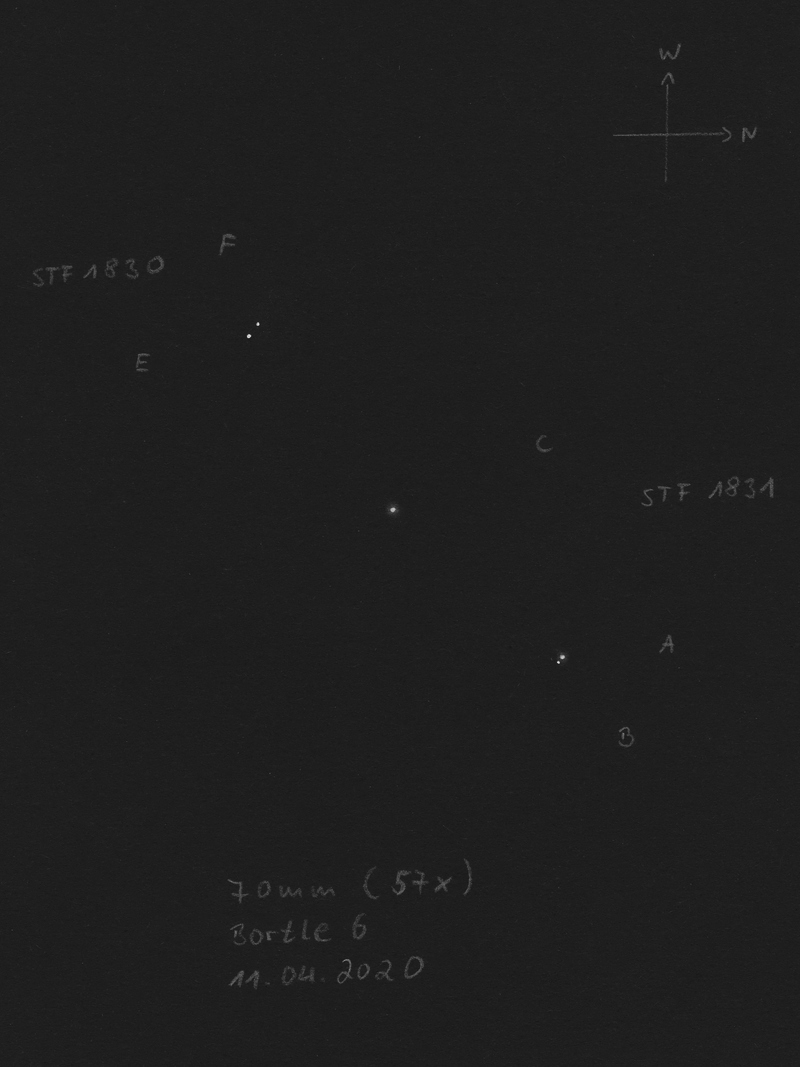
|
|
B 8x40
STF1831 (AC): 2020-04-05: Fairly wide pair with slight differences in brightness and color. C appeared slightly orange, A on the other hand slightly bluish. Comparatively bright double star, which gives a nice view.
|
|
55mm f/9.1, 27x
STF1831 (AC): 2020-04-05: Moderate difference in brightness. C: pale orange, A: subtle blue.
|
|
| René Merting |
12.5" f/4.5, 72x, SQM-L 21.0
EF: bei 72x ein schwaches Sternpaar, gut getrennt - E ist gelblich, F eine halbe Größenklasse schwächer und grau
EG: bei 72 ist nordöstlich von EF noch ein ganz schwacher Lichtpunkt erkennbar - G hat ungefähr mit dreifachem Abstand EF
|
|
B 15x56, SQM-L 21.0
AC: beide Sterne sind gleich hell und mehr als komfortabel voneinander getrennt\CE: Komponente E im Südwesten von C fällt ebenfalls sofort ins Auge, wenn auch der Stern deutlich schwächer ist - Abstand zu C in etwa so groß, wie der Abstand AC
|
|
12.5" f/4.5, 72x, SQM-L 21.0
AB: bei 144x ist B ein bisschen mehr als knapp getrennt im SO von A erkennbar - B ist deutlich schwächer und grau gegen den weißgelblich strahlenden A - zurück auf 72x kann ich die beiden auch noch extrem knapp getrennt erkennen in guten Momenten - ein schönes Doppel zusammen mit STF1830 EF
AC: bei 72x fällt die helle Komponente C im Südwesten von AB zwar auf, ich hätte aber nicht vermutet, dass der Stern dazu gehört
|
|
|
STT 241 (**)
|
| Name: |
STT241 |
| Type: |
** |
| Constellation: |
UMa |
| Coordinates: |
11h56m17.24s / +35°26'53.30" |
| Components: |
|
|
m1 |
m2 |
ρ |
θ |
Year |
|
|
6m.8 |
8m.7 |
1.8" |
148° |
2021 |
|
|
|
|
|

|
|
| Robert Zebahl |
120mm f/5, 200x, Bortle 6-, SQM-L 19.0
2021-04-04: Well separated with noticeable difference in brightness.
|
|
|
STT 575 (**)
|
| Name: |
STT575, 62 UMa |
| Type: |
** |
| Constellation: |
UMa |
| Coordinates: |
11h41m34.26s / +31°44'45.80" |
| Components: |
|
|
m1 |
m2 |
ρ |
θ |
Year |
|
AB |
5m.8 |
9m.8 |
42.8" |
313° |
2023 |
|
| René Merting |
100mm f/6.4, 32x, SQM-L 21.0
bei 32x habe ich B zunächst suchen müssen - Komponente A ist schön hell, B zeigt sich in ordentlichem Abstand nordwestlich von A, Helligkeitsunterschied 3 Magnituden - zurück auf 20x kann ich B auch noch wahrnehmen, aber nur weil ich wusste, wohin ich schauen muss
|
|
|
STTA 109 (**)
|
| Name: |
STTA109 |
| Type: |
** |
| Constellation: |
UMa |
| Coordinates: |
11h15m43.64s / +45°51'18.40" |
| Components: |
|
|
m1 |
m2 |
ρ |
θ |
Year |
|
|
8m.0 |
8m.7 |
83.8" |
256° |
2015 |
|
| René Merting |
107mm f/5.6, 30x, SQM-L 21.3
bei 30x zeigen sich zwei relativ schwache Sterne - Helligkeitsunterschied eine halbe Magnitude - die A-Komponente im Osten wirkt Strohgelb, B zeigt sich mit einem Stich ins Blaugraue, dadurch ein schöner Farbkontrast - bei 60x wirken die Farben noch ein klein wenig intensiver
|
|
|
Winnecke 3 (**)
|
| Name: |
Winnecke 3, WNC3 |
| Type: |
** |
| Constellation: |
UMa |
| Coordinates: |
11h18m58.50s / +51°18'12.70" |
| Components: |
|
|
m1 |
m2 |
ρ |
θ |
Year |
|
|
9m.0 |
10m.5 |
6.7" |
208° |
2019 |
|
| René Merting |
12.5" f/4.5, 72x, SQM-L 21.0
Zenitbeobachtung - bei 72x ist Komponente B mit leichtem Abstand getrennt von A erkennbar - Helligkeitsunterschied zwei Größenklassen - Komponente A wirkt gelblich, B kommt ohne Farbe aus, das reicht aber für einen kleinen feinen Farbkontrast
|
|
|
WX UMa (**)
|
| Name: |
WX UMa |
| Type: |
** |
| Constellation: |
UMa |
| Coordinates: |
11h05m27.65s / +43°31'38.70" |
| Components: |
|
|
m1 |
m2 |
ρ |
θ |
Year |
| VBS18 |
AB |
8m.8 |
14m.6 |
32.6" |
124° |
2023 |
| CSN7 |
AC |
7m.9 |
- |
7.3" |
168° |
2003 |
|
| Robert Zebahl |
70mm f/5.7, 100x, Seeing 3-4/5
AC: 2020-03-31: Not identifiable at magnifications between 22x and 100x. WX UMa (component A?) is a variable (b14m2-16m53) and probably too faint.
|
|
|